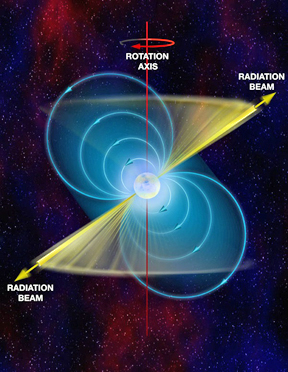|
Since
2016, the gravitational waves discoveries of LIGO/VIRGO have thrilled
astrophysicists. This array of three observatories has detected the
cataclysmic mergers of: (1) pairs of very massive black
holes, (2) pairs of neutron stars, and (3) neutron stars with
black holes.
This sketch suggests gravitational waves created by two black holes in a tight mutual orbit.

LIGO/VIRGO opened a new window to the cosmos and will, no doubt, continue to make thrilling discoveries for many years to come.
The
black hole masses in the detected mergers range from 8 to 85 Msun (Msun
is the mass of our Sun). This means, at merger, the colliding bodies
were orbiting one another several hundred times per second (several 100
Hz), and the peak gravitational wave frequencies were twice that.
As
the masses of merging black holes increase, so do their event horizon
radii. Hence, they “collide” when their centers are farther apart,
reducing the peak gravitational wave frequency. Indeed, peak frequency
is inversely proportional to mass in these events.
The next new frontier is searching for gravitational waves of very low frequency generated by supermassive black hole binaries.
Supermassive black holes, with masses up to 60 billion Msun, typically occupy the centers of major galaxies.
Galaxies
grow by merger and acquisition that gradually evolve on a time scale of
billions of years. We see countless examples of these mergers at
various stages.
When
two large galaxies merge, their central supermassive black holes
eventually merge as well, perhaps over 100 of millions of years or more.
As these supermassives approach one another, they become a binary
system in a mutual orbit of great size, emitting gravitational waves of
very low frequency.
No
one is patient enough to search for waves that oscillate once per
century, but astrophysicists are patient enough to search for waves that
oscillate once per decade, a frequency of 3 nHz (3 billionths of 1 Hz).
However, we can’t do that on Earth — we have to look to the heavens.

Pulsars
meet this need. As, sketched here, pulsars are rapidly rotating neutron
stars with strong magnetic fields that sweep radiation across the
cosmos, like lighthouse beacons. Their very large masses provide
enormous inertia, making their rotation rate extremely stable. As
gravitational waves pass between a pulsar and Earth, the space between
us stretches and compresses, changing the arrival time of the pulsar
beam.
Astrophysicists
have established, and are aggressively expanding, the capability of
monitoring large numbers of pulsars throughout the sky. The IPTA
(International Pulsar Timing Array) now regularly monitors 100 pulsars,
each of which spins hundreds of times per second and whose pulse arrival
time jitter is less than 300 ns.
Based
on 11 years of pulsar timing observations, the NANOGrav (North
American) portion of IPTA recently reported detecting random,
oscillating, spatial distortions coming from all directions in the sky, a
so-called isotropic stochastic background. The observed
distortions occurred at frequencies between 3 and 700 nHz, with a median
strain of 2 parts in 1000 trillion. (Strain is the fractional length
change.) NANOGrav was unable to confirm that these spatial distortions
had gravitational waves’ distinctive quadrupole signature (stretch and
compression in orthogonal transverse directions).
If NANOGrav’s effect is due to gravitational waves, the most probable sources are binary supermassive black holes.
Another
group proposes testing this hypothesis by targeting 13 known
supermassive black hole binaries with measured masses and orbital
periods. Their orbital periods range from 1 to 11 years, their masses
range from 1.2 to 18 billion Msun, and the strains they
generate here are between 1 and 72 parts in 10,000 trillion.
(Fortunately for life on Earth, there are no black holes that massive in
our galaxy, binary or otherwise.)
Hunting
for signals from a known direction and frequency greatly improves the
odds of detection, as will more years of observation, and the addition
of more monitored pulsars.
This
latter group estimates that, by 2025, IPTA will observe oscillating,
spatial distortions from 3 of the 13 targets with signal to noise (S/N)
ratios exceeding 3, corresponding to about 99% statistical confidence.
By the early 2030’s, IPTA could have S/N > 3, and possibly > 6,
for all 13 targets. This would firmly establish these signals being
gravitational waves from supermassive black hole binaries.
An
essential advantage of detecting this type of gravitational waves is
that they will continue and grow ever stronger for millions of years, as
the supermassive binaries get closer and orbit faster. This will enable
very precise measurements and much greater insight into the physics of
the most extreme creations of nature. By comparison, the LIGO/VIRGO
events last tenths of a second.
We just need to be patient.
Best Wishes,
Robert

September 2021
Note: Previous newsletters can be found on my website.
|